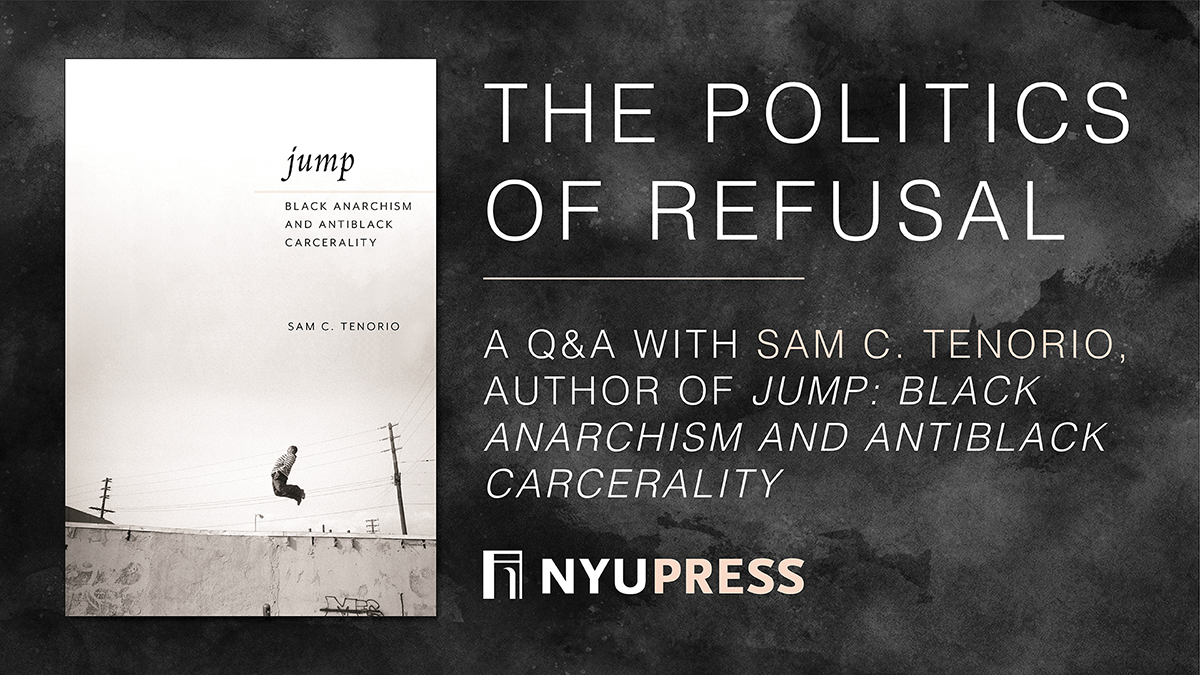Jumping Ship — You open your book with several provocative quotes calling to mind the historic act of enslaved people jumping from the ships of the Middle Passage, the first of which is from Marvel’s 2018 movie Black Panther. Erik “Killmonger” Stevens refuses to be healed by the movie’s hero and instead chooses to die, saying, “Just bury me in the ocean with my ancestors that jumped from the ships because they knew death was better than bondage.” How does this narrative of “jumping” from slave ships pervade popular culture and literature, and what inspired you to take up this action as the central theme of your book?
When I saw the scene in Black Panther, I was both surprised and not. The film came out after I had already done years of research mapping out these jumps of the enslaved, and I had grown accustomed to finding the jump in unlikely places. Whenever someone would find out about my book, they would tell me about an example. But the fact that such jumps are referenced in the film only confirmed, for me, that they emerge to unsettle our conventional political frames. In the context of the film, that’s the well-worn dichotomy of vilifying black militancy and celebrating a kind of liberal racial inclusion. There was pushback when I started to pursue this project, from people who believed it was either too defeatist and depressing, or that I was making too much out of nothing. There’s a quote I return to time and time again from Christina Sharpe in an interview she gave in Rhizomes with Selamawit Terrefe. When she discusses the resistance to the imposition of nonbeing, she says, “It doesn’t rupture the totality. But that doesn’t mean that we don’t have to attend to it.” This book became an attempt to attend to it.
Refusal – In this chapter, you write about the enslaved Black boy, Pip, in Herman Melville’s Moby Dick, whose jump from the whaling ship offers, “a refusal of the master’s authority, of authority in toto.” How does Pip’s story help us understand a politics of refusal of racial authority?
Pip’s story is where this book started. I was reading Moby Dick for a class in Political Theory, and I was struck by everyone’s sidestepping of Stubb’s appeal to the auction block and Pip’s slaveability. He’s a young Black cabin boy on the Pequod who at one point has to take over for an injured after-oarsman in Stubb’s whaling boat. The first time he jumps he does so because he gets scared of a whale they’re chasing and he gets caught in the harpoon line. Stubb begrudgingly cuts him loose and then chastises him saying, “We can’t afford to lose whales by the likes of you; a whale would sell for thirty times what you would, Pip, in Alabama.” No one felt the need to discuss how antiblackness was structuring this scene. Pip’s Blackness seemed to matter to the point of unmattering, just context for his lowly status on the ship and his tambourine. Scholars have written about Pip at length, but never, it seems, about antiblackness. The jump isn’t discussed in relation to Stubb’s violence.
As I started to work on this project, I recognized a twinned political order: the antiblackness that structures the ship as representative of Western modernity and Ishmael’s (and scholars’) narration of that political order meant to disappear antiblackness. Readings of Pip’s jumps are often deracinated and depoliticized, but I wanted to know what could be gleaned from viewing his jumps alongside the historical practice of the enslaved (oftentimes enslaved women) jumping from the slave ship. By taking Pip’s jumps as a refusal, we see that he’s not just refusing Stubb’s threat, but he’s also unsettling Ishmael’s desire to find commonality and analogy. Placing the jump outside the hem of politics, often in favor of more conventional forms of resistance like ship takeovers, can protect liberal horizons. Thinking through these jumps allowed me to think through black anarchism and vice versa, and how they both refuse Western Modernity’s order and antiblackness as that order from chattel slavery to its afterlives. Looking at these jumps as an anatomy of black anarchist practice allowed me to see them emerge in different carceral geographies as refusals of the antiblackness that authorized and is authorized by these geographies.
Collectivity – The voyages of the Black Star Line, the shipping line of Marcus Garvey and the United Negro Improvement Association, are generally considered to be an economic failure tied to Garvey’s own imperial aims. However, you argue that Black anarchism offers a different reading of this historic moment. How do you define Black anarchism as distinct from Classical anarchism, and how does it change our understanding of the Black diaspora’s relationship to the nation state?
The chapter on the Black Star Line was, in some ways, the most challenging one to write because Marcus Garvey is not without political controversy within Black Studies. I’ve been asked “How can you tell me Garvey is an anarchist?” I’m not. The chapter isn’t about Garvey as much as it’s about his ships, and these ships have been excised from a generative conversation about political practice because of both an economically fueled reading that is aligned with white notions of capital accumulation and a dismissal of black nationalism.
White anarchism has long dismissed Black radical practice because of its dismissal of Black nationalism as aligned with the state. But I argue that the state contested by Classical anarchism and the state refused by black anarchism are fundamentally different. Classical anarchism is ultimately a class-based politics that goes racially unmarked, but the ships emerge as a Black diasporic critique—one that is driven by Black collectivity—of white nation building and its carceral constraints. This critique resists the colonial-racial authority embodied in the state. Unlike the unmarked state of Classical anarchism, black anarchism challenges an antiblack state by naming the antiblack foundation of the state.
Ruination — The Watts Rebellion of 1965 remains famous for its material destruction of property, including acts of arson, theft, and vandalism. These actions are labeled cathartic, criminal, and senseless, and they have been taken up by talking heads who claim that the destruction of property delegitimizes political protest. How does the Watts Rebellion disrupt our conceptions of property, and law and order? How is this relevant to protests today?
I open the chapter on Watts by reflecting on The L.A. Times’s semicentennial retrospect on the rebellion, published just one year after the uprising in Ferguson that followed Michael Brown’s murder by the police. Historian Robin D.G. Kelley cautions that the 50th anniversary will bring crude reductions to gruesome violence and destruction, which is true, and then concludes that “what they burned is less important than what they built,” couched in the assessment that “a focus on violence and looting” fails to engage residents’ actual confrontation with “social and economic catastrophe.” But for me it begged the question, what if the opposite is true? What if the destruction was part of Black Angelenos’ confrontation with the matters of property and law and order that govern black life? Destruction is uncomfortable, and Watts protesters in 1965 have been sensationalized as opportunists setting fire to their community through the media’s repetition of “burn baby burn.” Yet protesters’ acts of vandalism actually place the ghetto and the property relations of antiblackness in relief, demonstrating that they don’t get to own these neighborhoods, they’re only housed there. Despite characterizations running the gamut of desultory and reactionary to criminal and cathartic, these destructive practices abut the state’s own propertied analysis and solutions. They propose questions of property itself and interrupting an ever-growing nexus paying fealty to law and order. Listening at the socio-spatial register allows us to hear the rebellion differently, where ruination counters the state fables of the common good and crime prevention told through environmental design that inalienably link property and the police. This same sensationalism and misrecognition happens in 2014, in 2015, and in 2020. Black protesters are being told to act appropriately, that they can protest but they have to respect the laws when doing so. But when you’re protesting the law, the expectation to respect it is bunk. When the political practices are being delegitimized by the very structural relations that these practices are calling into question—this is a crisis that black protest raises for Western liberal democracy.
Maneuvers — You trace the history of antiblack carcerality from the slave ship to the modern prison industrial complex. In your final chapter, you tell the story of Assata Shakur — both her physical escape from prison, and its textual reflection in her autobiography. How does her “jump” from prison demonstrate the broader politics of refusal you explore in the book? What comes after the “jump”?
I’m not the first scholar to draw this link between the slave ship and today’s prison and surveillance state. My work is indebted to Angela Davis, Simone Browne, Dennis Childs, and Christina Sharpe among others. For me, looking at the prison industrial complex as a descendent of the slave ship helps us see how mobility and movement too, rather than simply stagnation, are used to form antiblack carceral geographies. Incarceration isn’t just about being held in one place, but about being moved—about the conditions of oscillation and disorientation. The policing of movement is immanent in the history of Black criminalization, and I see this most in the concept of vagrancy which was and is broadly defined and broadly enforced to commit antiblack violence and criminalize Black (political) mobilizations. I focus on Assata Shakur’s escape from prison to Cuba because it issues a counter use of movement, one that reveals both the necessity of the jump but also its precarity. Upon her escape from one carceral geography, she hasn’t escaped the carceral conditioning of Blackness. She is still being pursued by the state and her image is still being used to police black communities across oceans. So I look at her escape as a dis-incarceration, one that is necessarily iterative and incomplete but must still be attended to as a disruption. Like Pip at the beginning of my book, Assata’s jump refuses the structural antagonism of antiblackness as much as she refuses the state’s narration and representation. This is why looking at her escape as an “absent chapter” in her autobiography reveals the necessity of opacity as it resists the representative requirements of political claim making as the route to liberation. It reveals a necessary fugitivity.
The question as to what comes after the jump is one I’m not very interested in pursuing for two reasons that I explore throughout the book. One is that the question of outcomes is used to constrain (and dismiss) Black political practice to the horizons and maintenance of the existing world. The second is that I don’t know. I don’t aim to be prescriptive, and the book doesn’t attempt to outline what is and isn’t anarchism for the purposes of creating a typology. The jump resists the repression of the referent, that is, it aims to reveal the antagonism. The jump, for me, also resists prefiguration; rather than provide answers, it asks questions.
Sam C. Tenorio is Assistant Professor in the Department of Women’s, Gender, and Sexuality Studies and the Department of African American Studies at The Pennsylvania State University.



 Six Classics of Queer Literature
Six Classics of Queer Literature